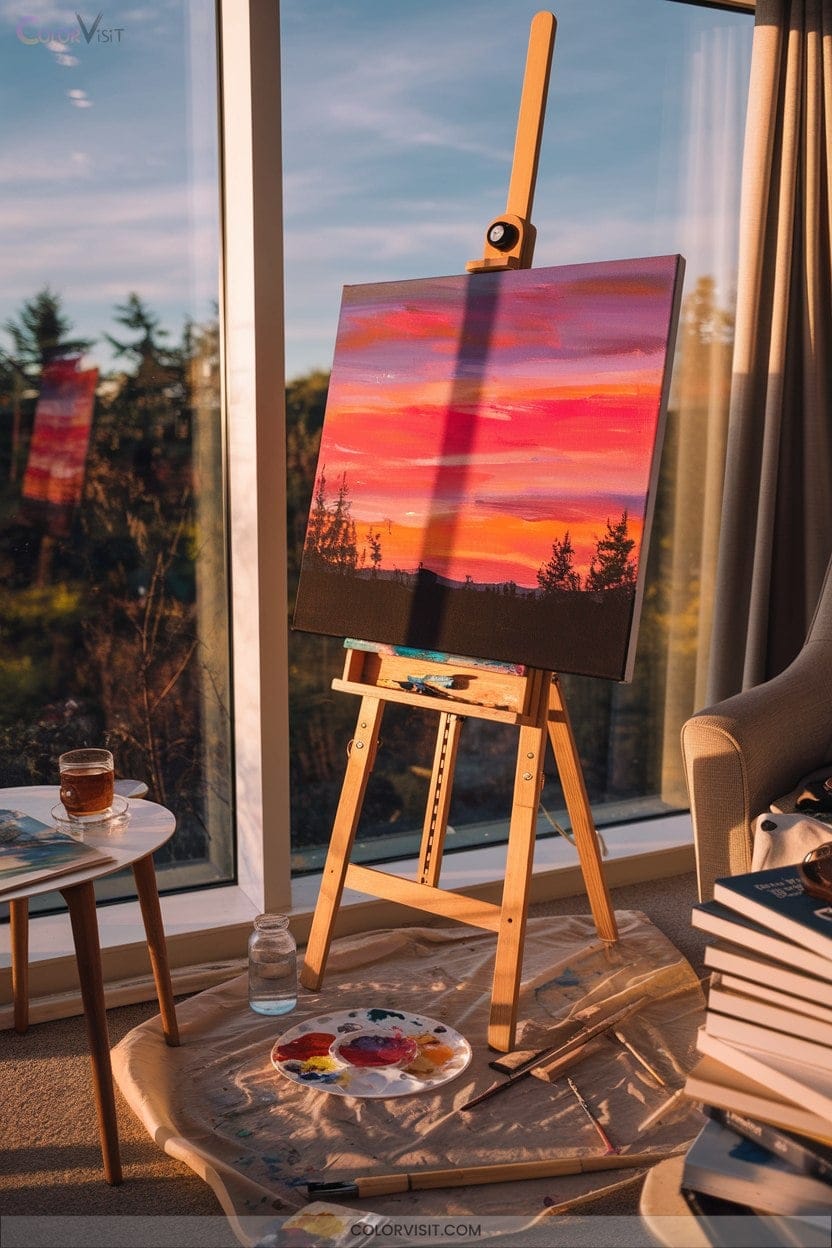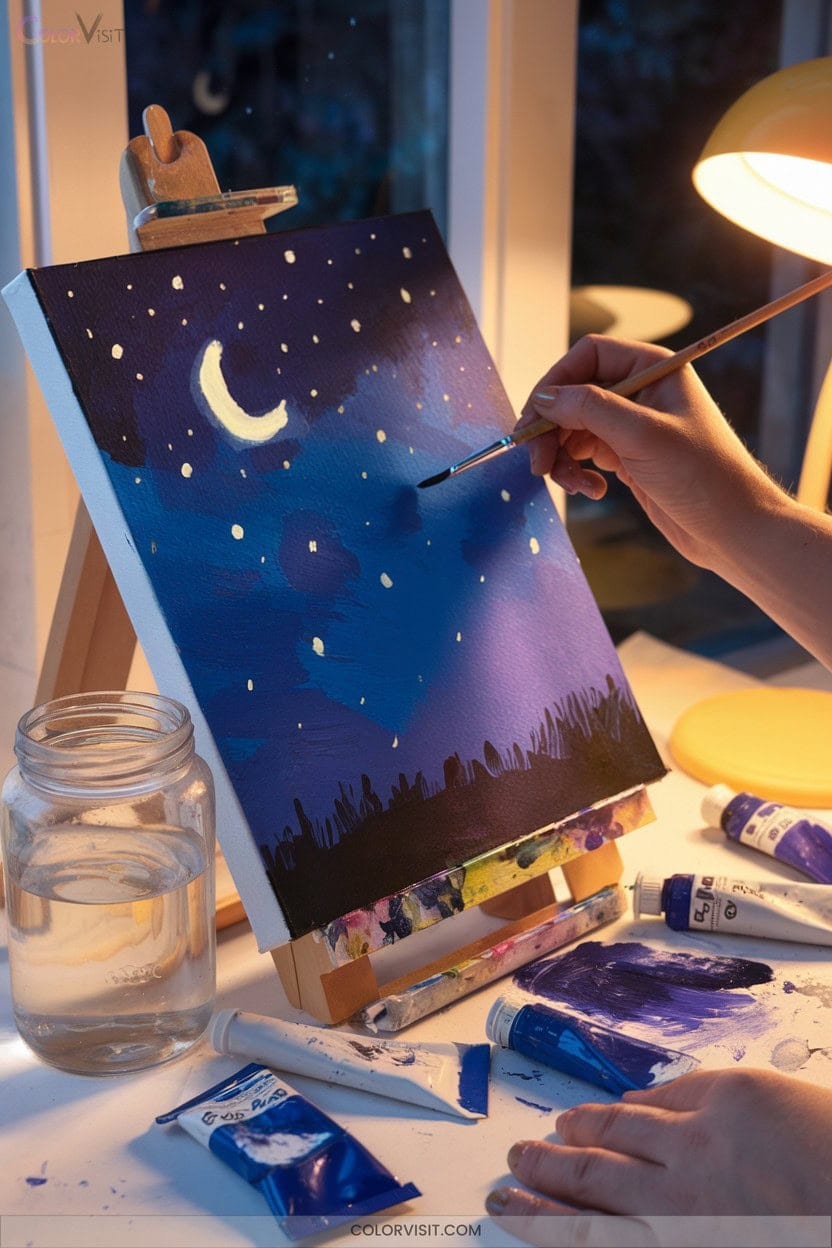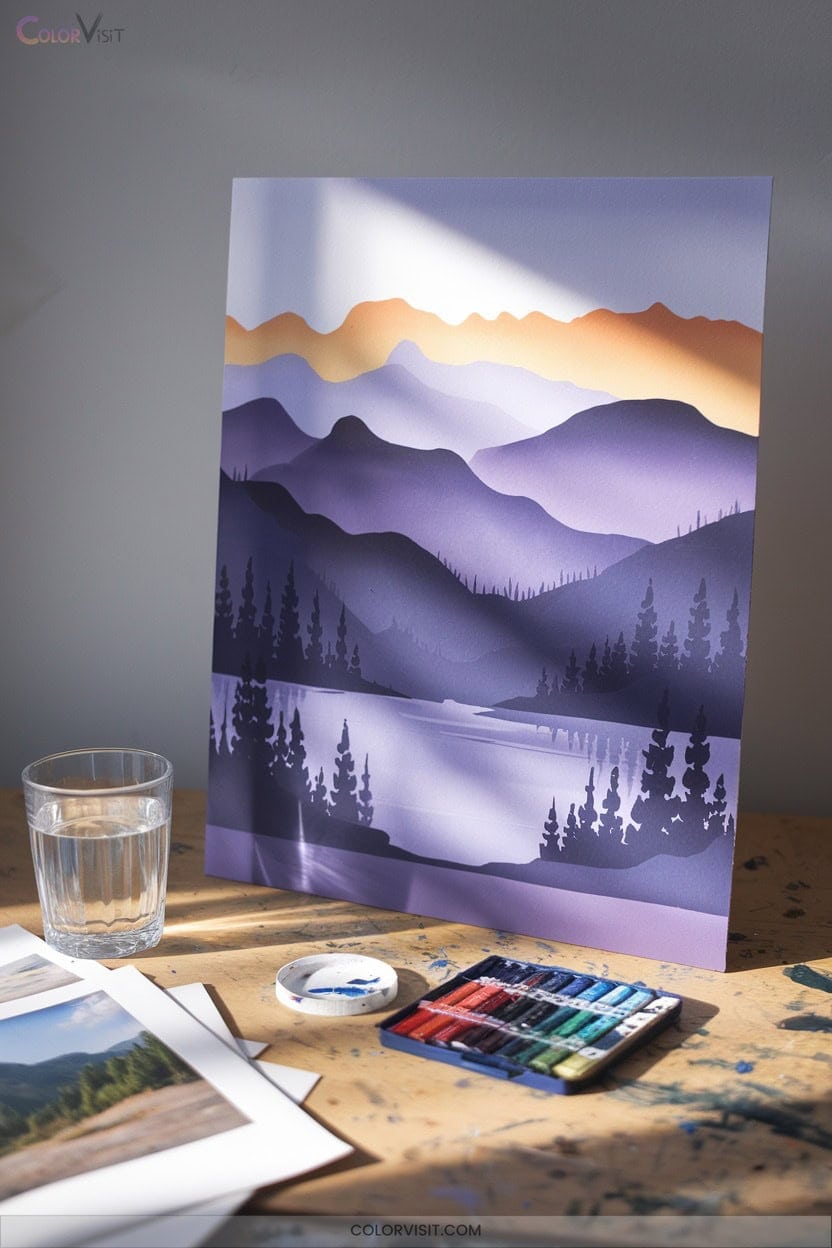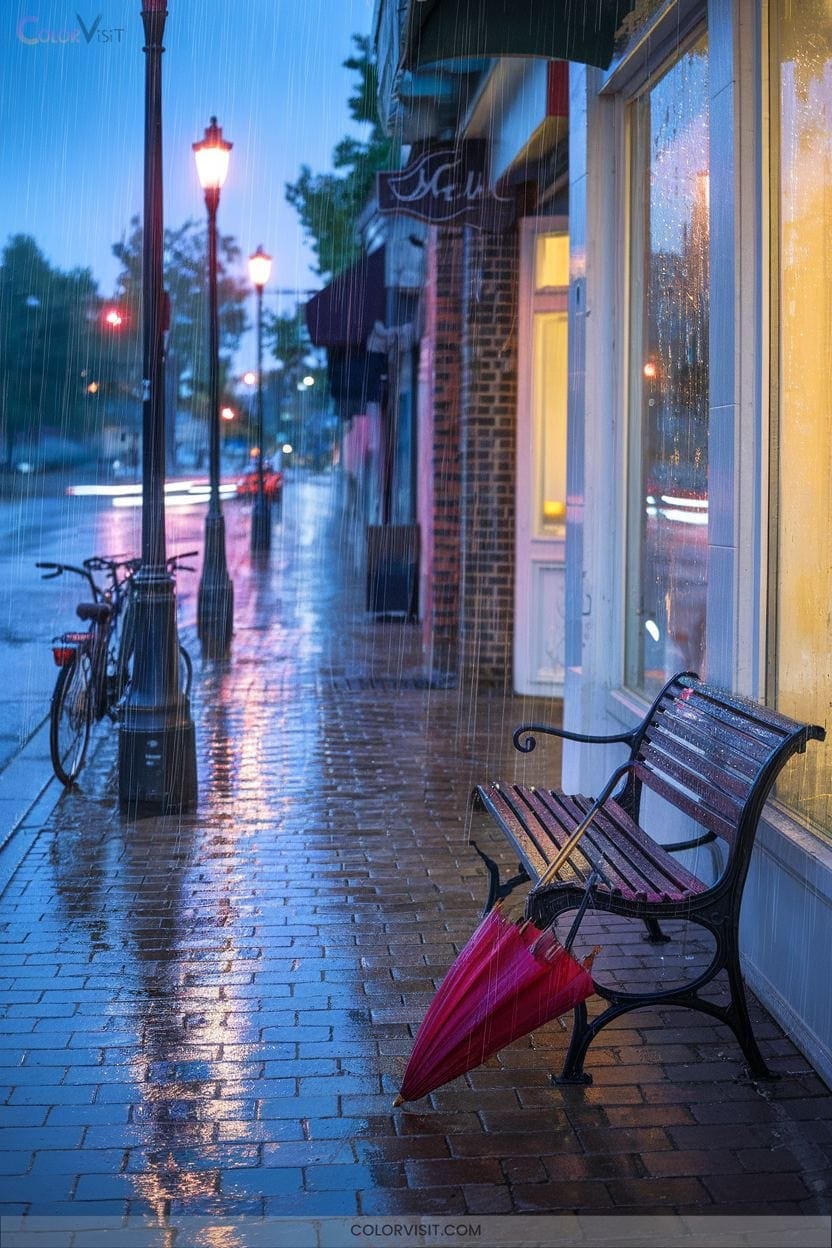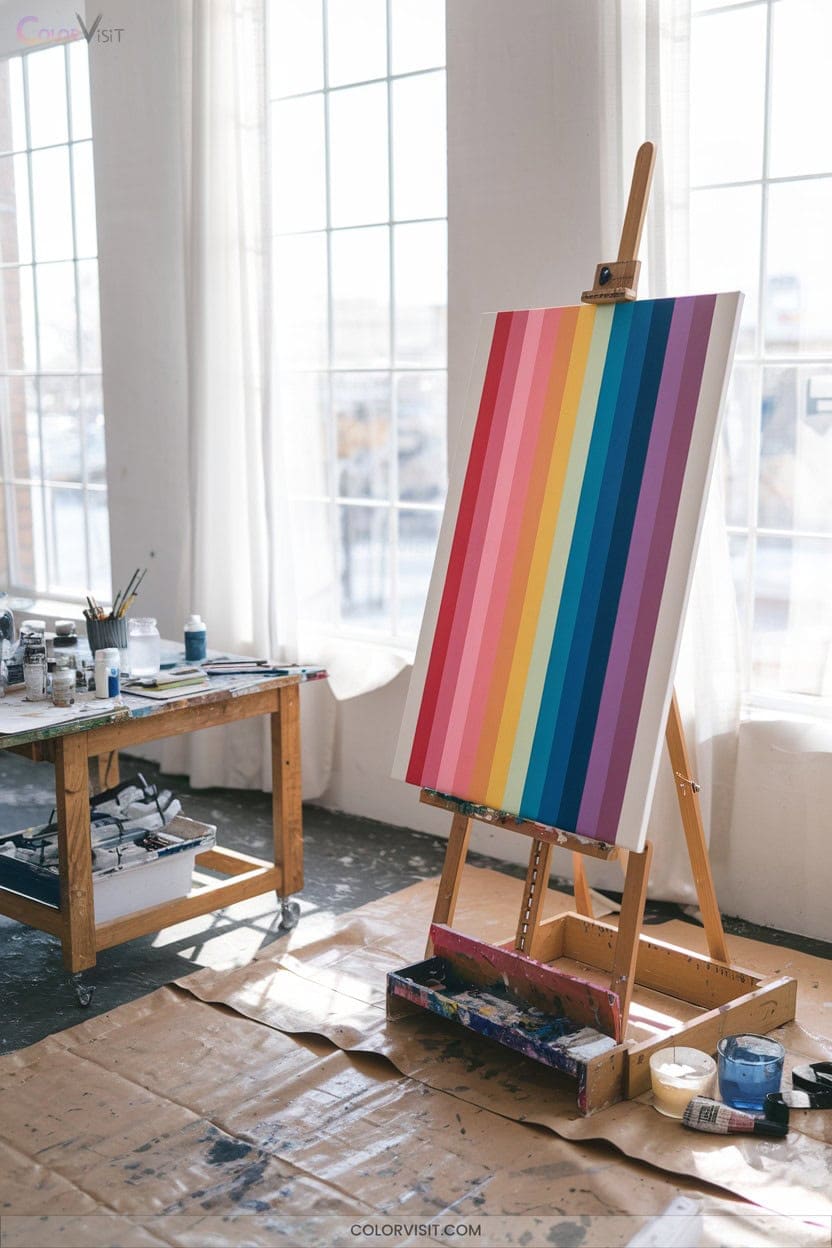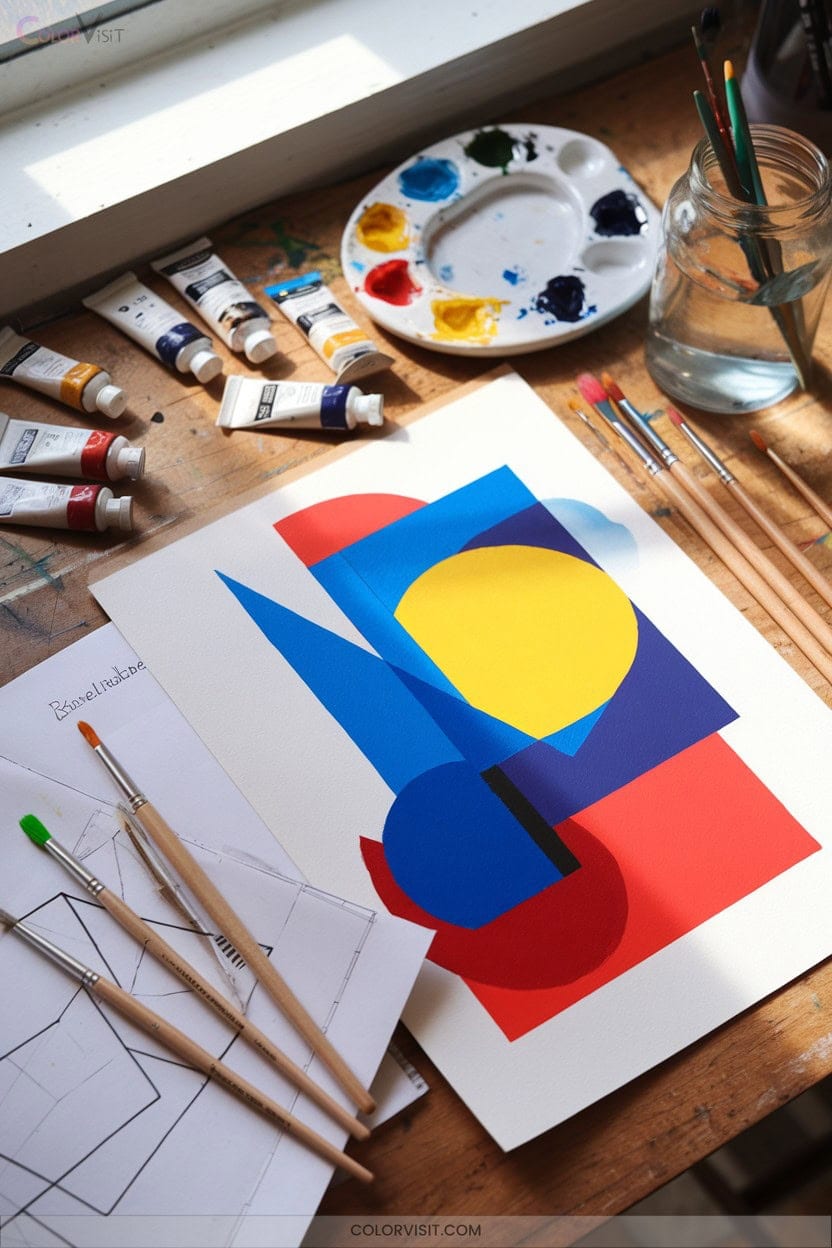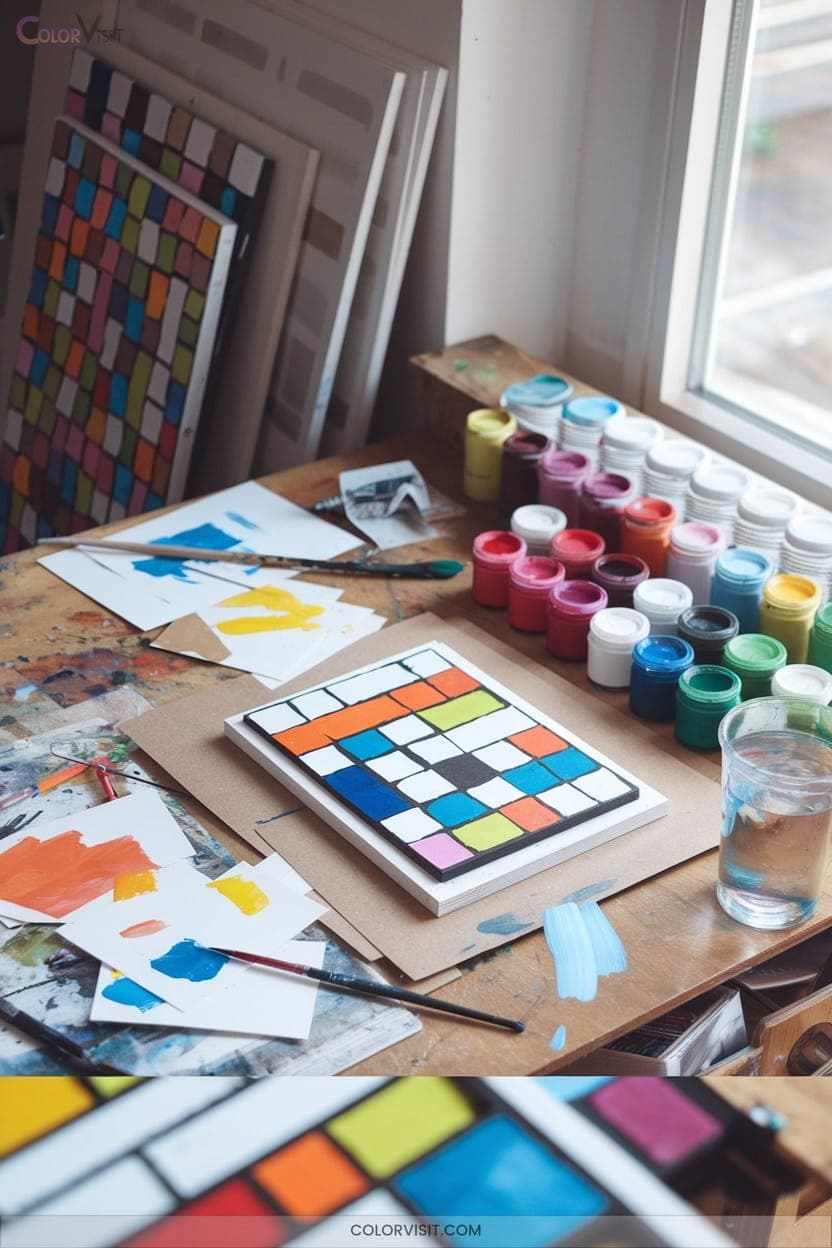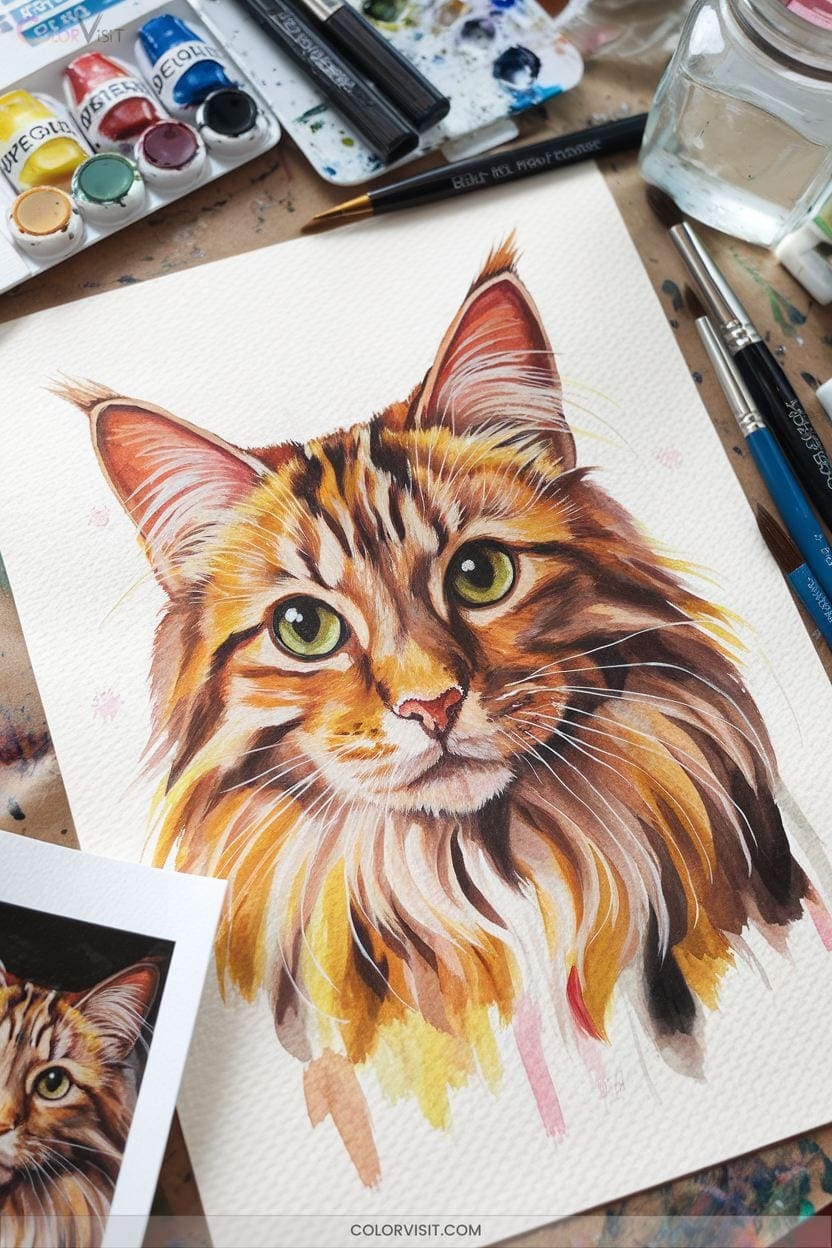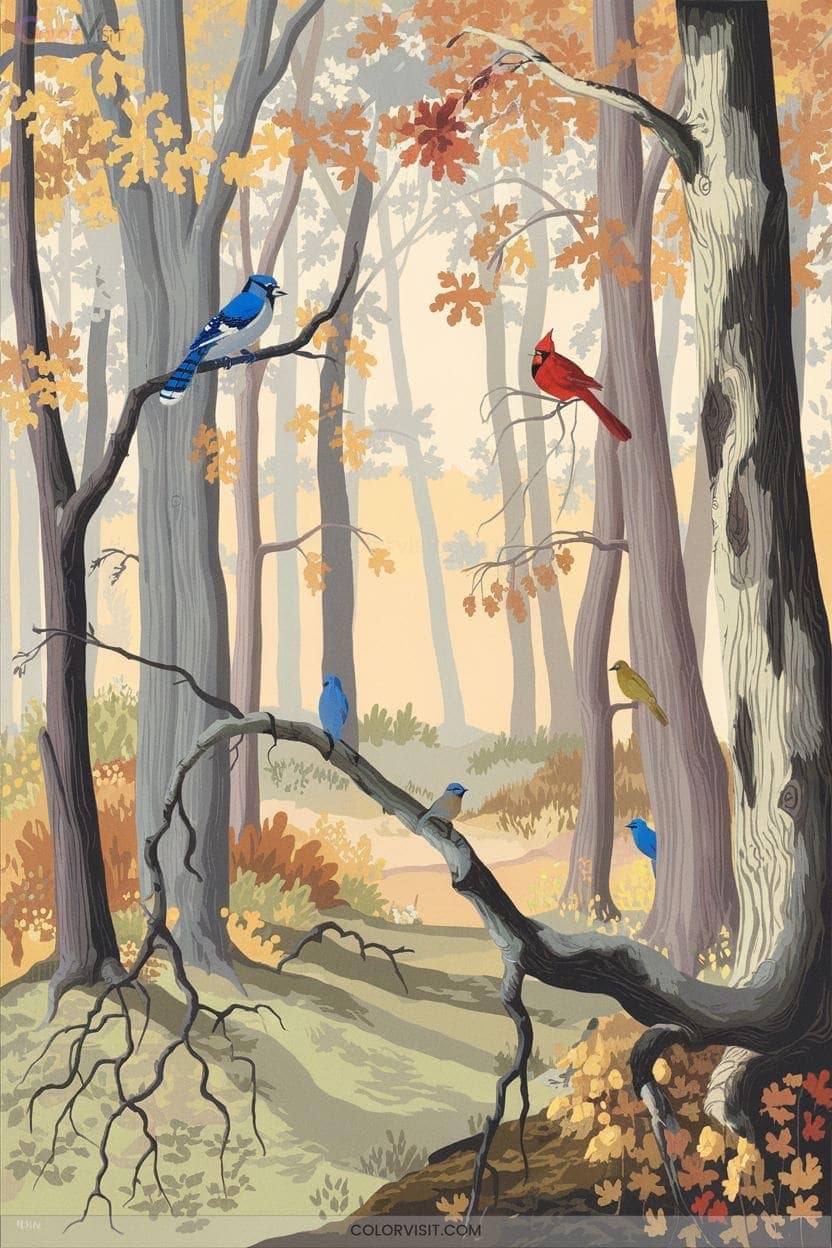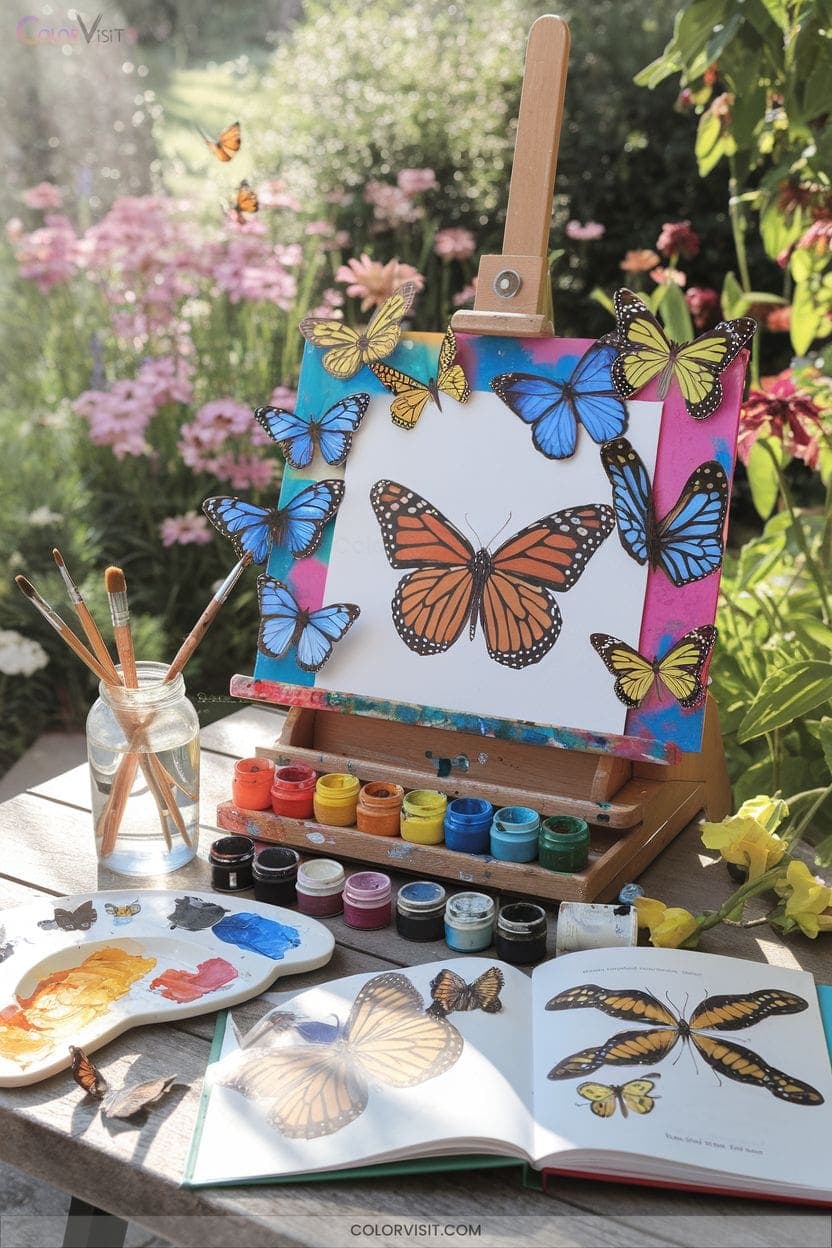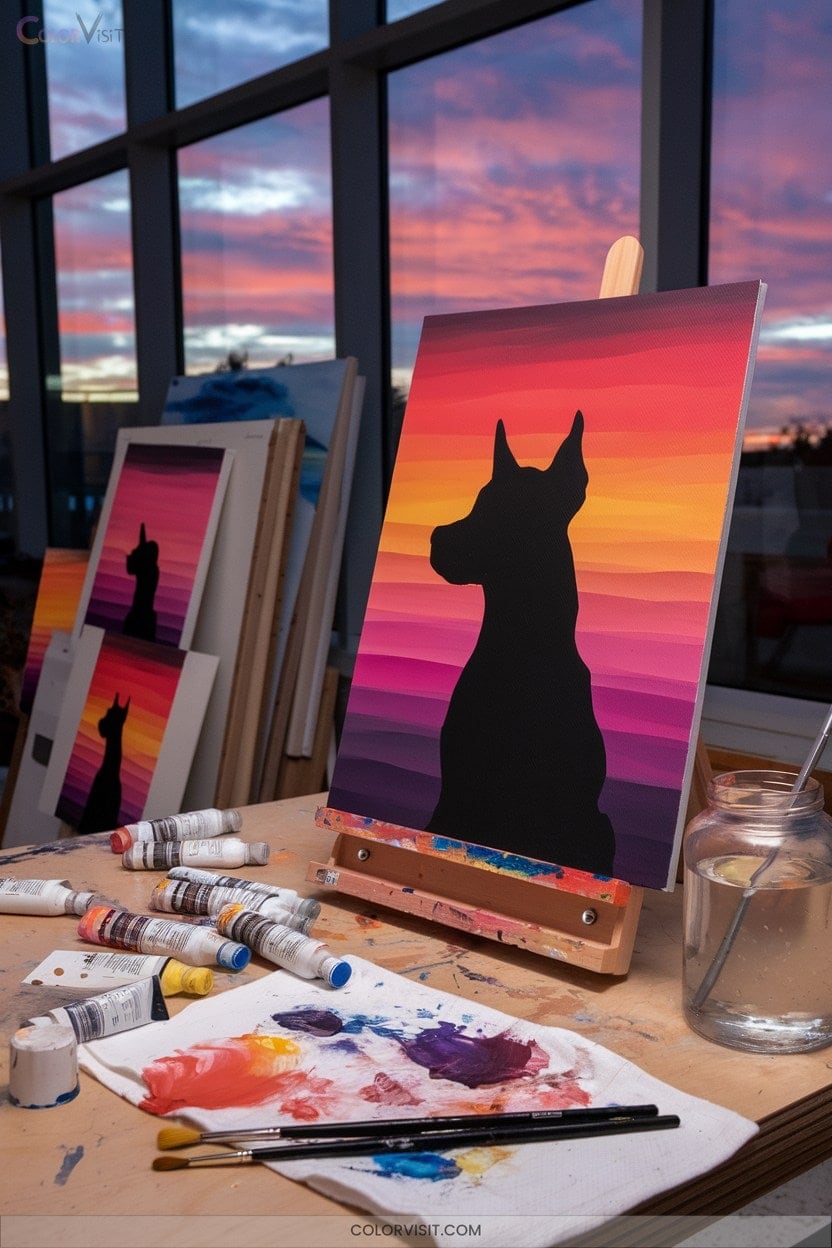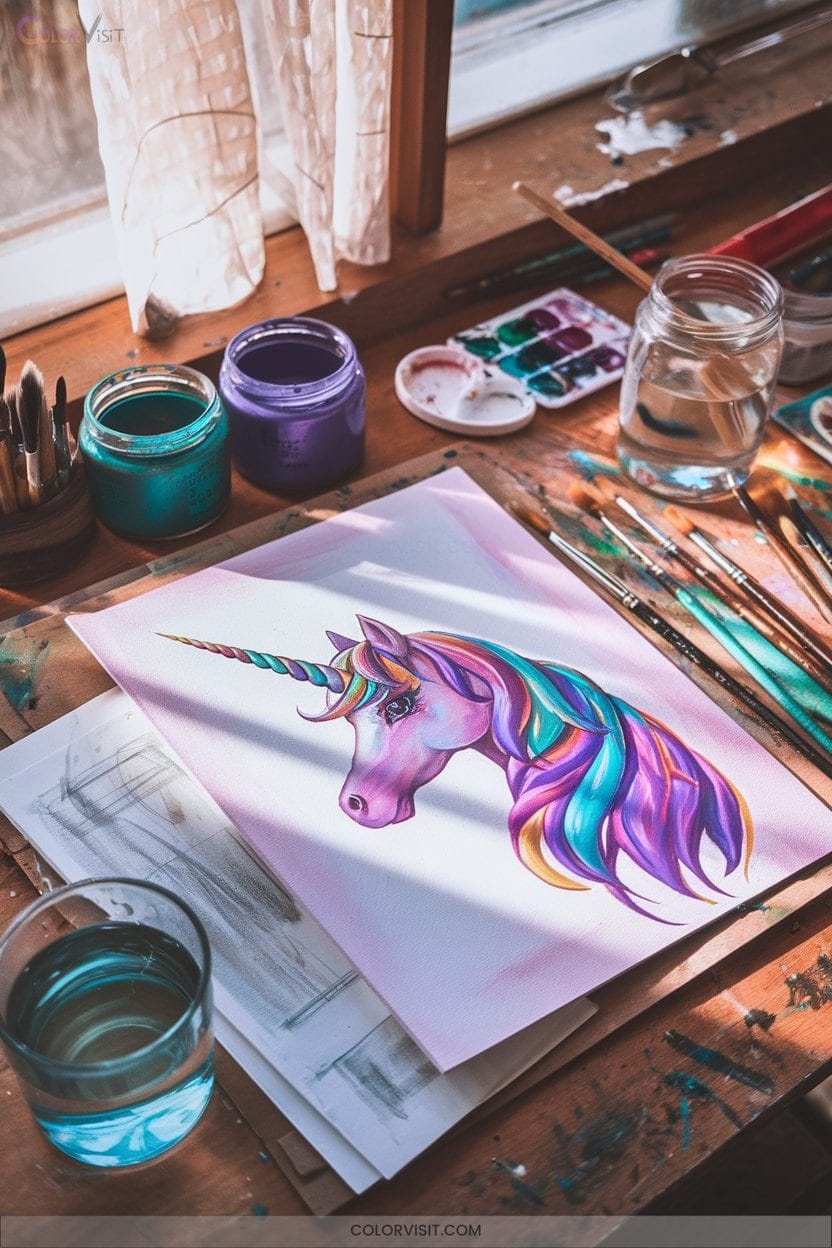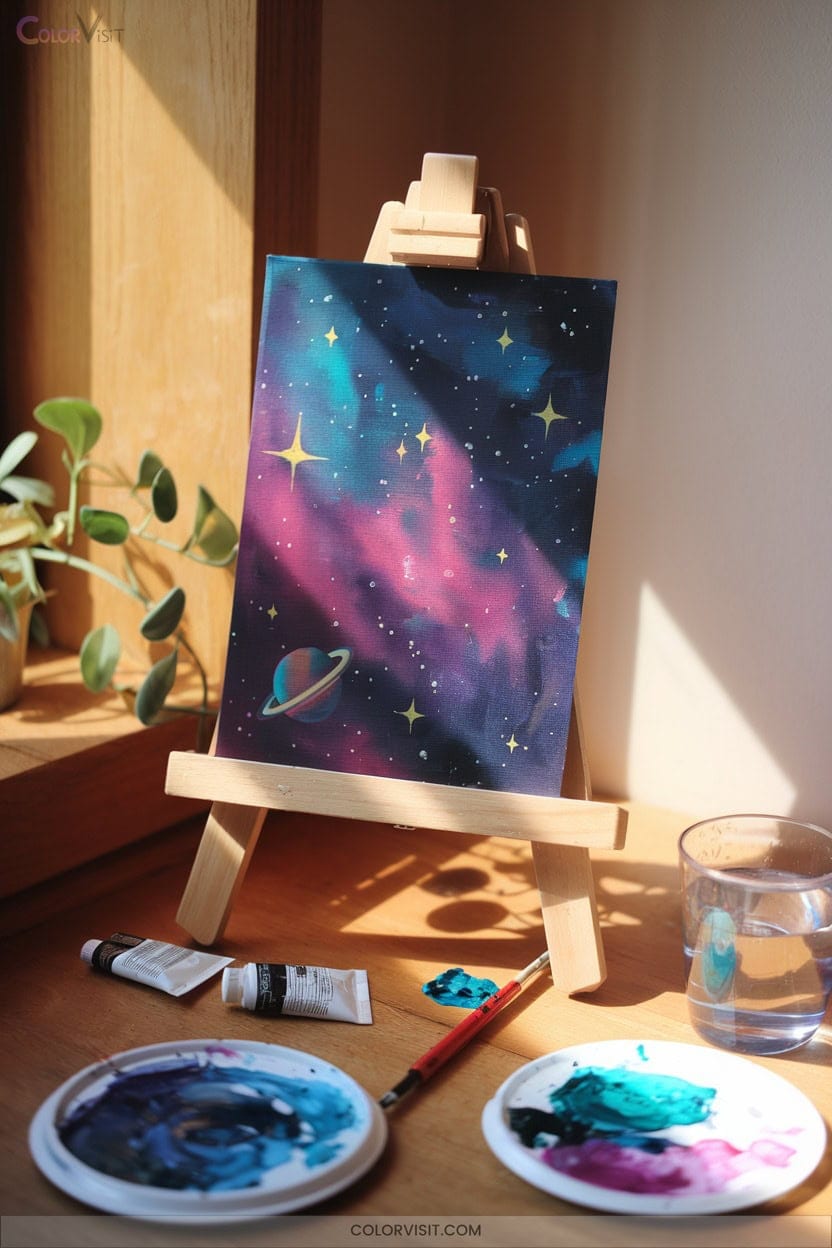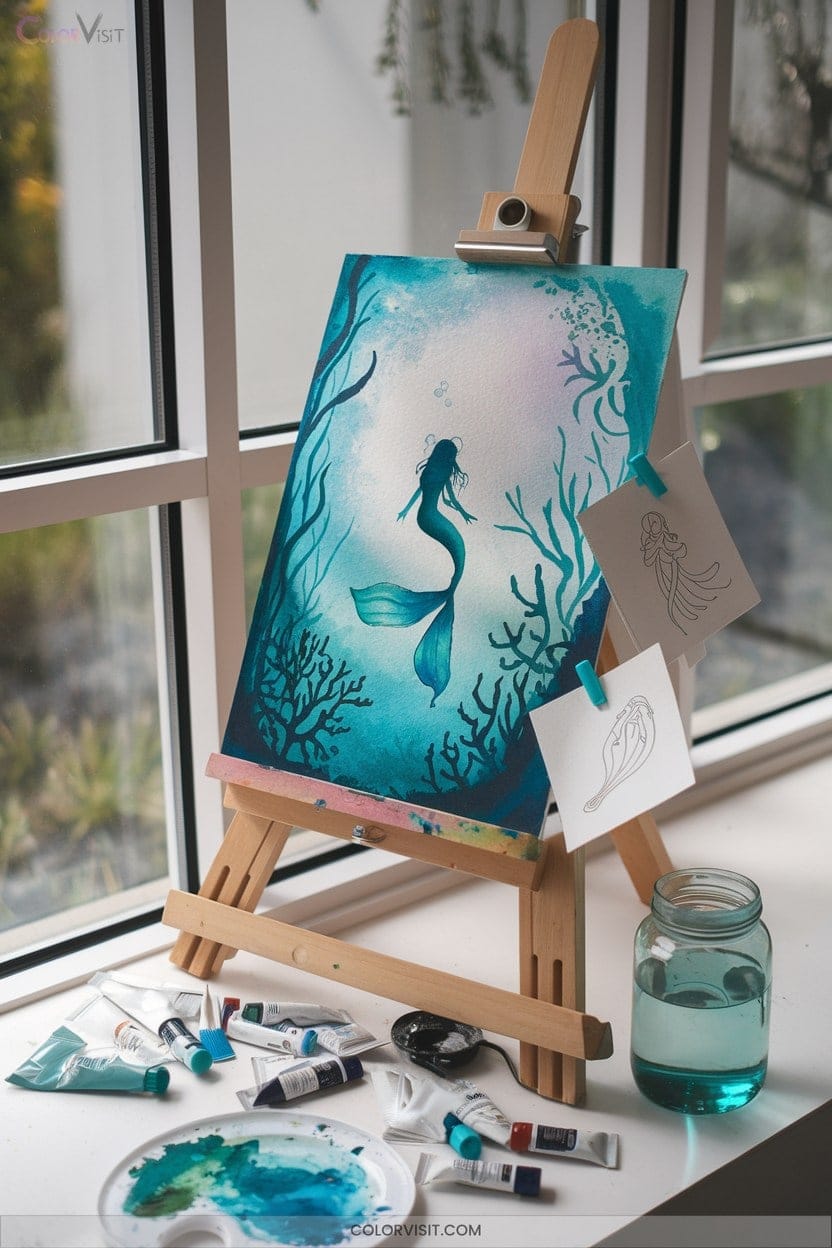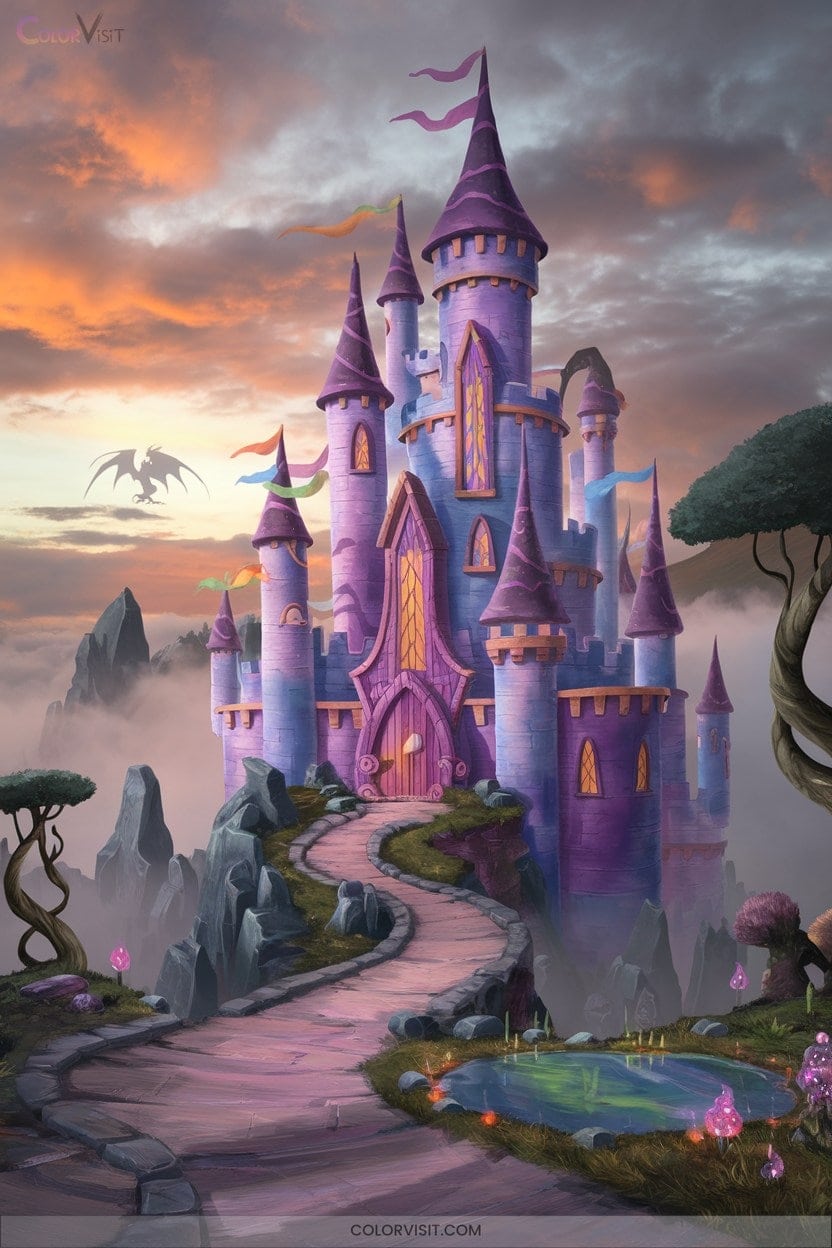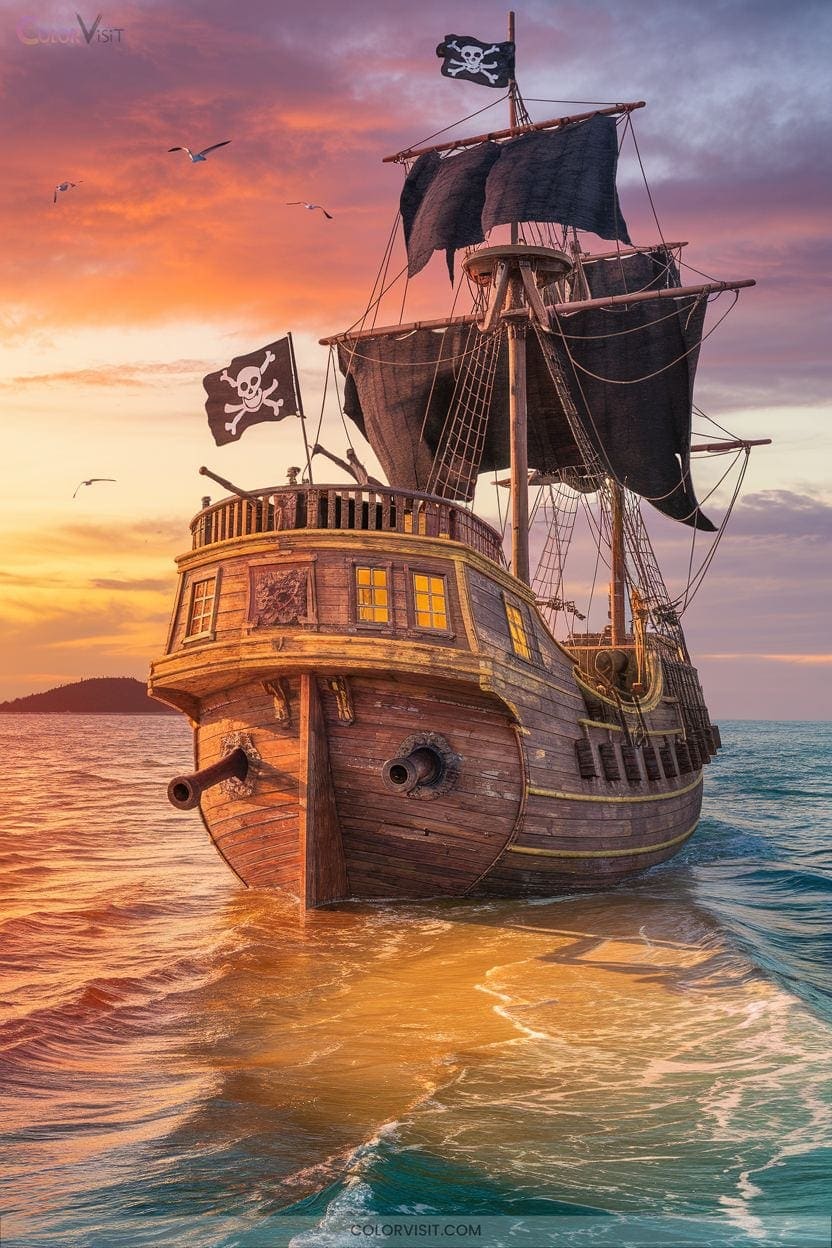20 Simple Poster Color Painting Ideas Easy Enough for Beginners
You can create 20 simple poster color paintings using techniques like sunset skies, night scenes, mountains, rainy moods, oceans, colorful stripes, and bold patterns.
Try painting geometric shapes, florals, splatter art, animal silhouettes, cat portraits, or birds in trees.
Focus on easy brushwork and simple layering—experiment with blending, tape for sharp edges, and basic animal sketches. Each project builds your confidence and skill, and the next steps will guide you through specific ideas for your creative journey.
1. Sunset Painting
A sunset painting is a perfect starting point for beginners enthusiastic to explore poster colors.
Begin with an 18×24 cm canvas and organize your palette—orange, yellow, ultramarine blue, burnt umber, white, and black.
Use an angular flat or filbert brush for horizontal strokes, blending wet colors to create smooth gradations from blue to warm hues.
Blend wet poster colors with an angular flat or filbert brush, using horizontal strokes to achieve smooth transitions from cool to warm tones.
Try double loading your brush for seamless blends.
Emphasize the sky by placing the horizon low.
Add silhouettes of trees or mountains for drama, and experiment with clouds or water reflections to innovate.
Regular practice and seeking feedback will sharpen your unique style.
2. Night Sky
Night-sky painting offers beginners an inviting way to explore color layering, blending, and creative expression with poster colors.
Start with ultramarine or primary blue as your base, then layer in violet and black for depth.
Blend smoothly for a seamless gradient—innovation comes from experimenting with brush types: try a fan brush for clouds or a liner for delicate stars.
Add white for a glowing moon or shimmering constellations, and don’t hesitate to incorporate pinks for emotional flair.
Use small canvases to keep things manageable.
Regular practice and playful color choices will help you develop a signature, imaginative night-sky style.
3. Mountain Scene
Building on the imaginative skills you’ve developed with night-sky painting, creating a mountain scene introduces new ways to explore structure and depth using poster colors.
Expand your creativity by painting mountain landscapes, discovering fresh techniques for structure and depth with vibrant poster colors.
Begin by sketching a central mountain and laying a diagonal composition; this adds instant drama.
Use a flat brush for the sky—blend phthalo blue, ultramarine, and white. Layer mountainsides with mixed blues and browns, deepening shadows with burnt sienna.
Shape distant trees using desaturated blue and yellow ochre. For innovative highlights, add warm snow using white plus a hint of yellow.
Finish with textured snow, tree silhouettes, and negative space to emphasize depth.
4. Rainy Scene
Ever wondered how to capture the mood of a rainy day with poster colors? Start by gathering your essentials—brushes, canvas or paper, a palette, and water.
Use the wash technique for soft rain effects, blend blues and grays for atmosphere, and add pops of color in reflections.
Experiment with drybrushing for wet pavement and stippling for texture.
Analyze real rainy scenes to innovate your approach.
- Observe how light reflects on wet surfaces.
- Layer colors to create depth and mood.
- Highlight raindrops for realism.
- Try different compositions, like city streets or parks.
- Share and seek feedback in art communities.
5. Ocean View
Ocean-view paintings offer a perfect opportunity to explore color harmony and brushwork while capturing the interplay between sea and sky.
Start by preparing your canvas and selecting a versatile palette of acrylics—blues and greens are essential, but don’t hesitate to innovate with unexpected accents.
Establish a crisp horizon using a dark blue, then experiment with gradient blends above and below.
Use thick, textured brushstrokes or even try the toilet paper technique for dynamic waves and foam.
Layer your paint to build depth, and add reflections for movement.
Balance your composition with subtle landforms or wildlife for visual intrigue.
6. Colorful Stripes
Why not infuse your artwork with energy by experimenting with colorful stripes?
Start by selecting your palette—use the color wheel for bold contrasts or harmonious hues.
Choose your colors thoughtfully; the color wheel is your guide to creating either striking contrasts or serene, harmonious stripe combinations.
Draw inspiration from nature, or go bold with bright shades balanced by a neutral background. Apply tape for sharp lines, brushes for smoothness, or sponges for texture.
Alternate stripe directions for movement and interest.
- Mix colors on a palette to innovate your stripe combinations.
- Use baby wipes for unique, smooth blends.
- Explore YouTube tutorials for new techniques.
- Alternate horizontal and vertical stripes for spatial illusions.
- Practice layering for depth and vibrancy.
7. Geometric Shapes
Geometric shapes offer a simple yet striking approach to poster color painting, making them perfect for beginners enthusiastic to explore bold forms and vibrant contrasts.
Start with a blank canvas, lightly sketch triangles, squares, or circles, and use masking tape for crisp edges.
Blend warm backgrounds—try orange and yellow—then splatter for texture.
Paint your shapes in cool tones, alternating between solid fills and transparent layers.
Add detail with contrasting paint markers—think dots, stripes, or zigzags.
Experiment with symmetry, white space, and muted palettes for a minimalist effect.
Let Scandinavian design and artists like Sonia Delaunay inspire your innovative compositions.
8. Floral Patterns
A floral pattern brings vibrancy and charm to your poster color paintings, offering endless possibilities for creative expression.
Start with basic brush techniques: use short strokes for petals, thin liners for stems, and dabbing for textured centers.
Experiment with color mixing—try analogous palettes, add white for highlights, and shift greens using split-primary methods.
Compose your florals with odd clusters, diagonal placements, and intentional negative space.
For beginners, daisies, tulips, and cherry blossoms are approachable yet visually striking.
- Embrace organic imperfections for natural appeal
- Layer wet-on-dry for petal depth
- Guide the eye with S-curve stems
- Preserve negative space
- Avoid overworking wet layers
9. Splatter Art
Splatter art energizes your poster color painting sessions with a sense of spontaneity and motion.
Splatter art brings dynamic energy and lively movement to your poster color painting, transforming each session into an expressive adventure.
Embrace creative freedom by flicking, dripping, or throwing watered-down paint onto your chosen surface—canvas, paper, or even fabric.
Tap brushes against your hand for more control, or experiment with different tools to vary your effects.
Remember to protect your workspace and wear old clothes as things can get messy. Channel the spirit of Jackson Pollock, letting emotion and movement guide you.
Try vibrant, contrasting colors for bold results.
Keep practicing; each attempt sharpens your technique and pushes your artistic boundaries in exciting, innovative directions.
10. Mosaic Art
Curious how you can turn simple materials into eye-catching art?
Mosaic art lets you break boundaries using everyday items—think glass tiles, wooden boards, even bottle caps.
Start by planning your design, scaling it to fit your chosen base. Use nippers to shape pieces, and secure them with adhesive.
Don’t forget to seal wooden surfaces and allow glue to dry overnight. Grout between tiles for a polished look.
As a beginner, keep it simple and experiment with patterns.
- Try recycled materials for unique texture
- Use templates to jump-start your design
- Practice safety with gloves and masks
- Explore both indoor and outdoor surfaces
- Let creativity drive your material choices
11. Cat Portrait
Once you’ve explored the vibrant world of mosaic art, painting a cat portrait offers a rewarding way to sharpen your observation and brushwork skills.
Begin by selecting a clear reference and sketching basic shapes to capture posture and proportion.
Mark facial guidelines so details like eyes and nose align naturally. Study feline anatomy; observe how muscles and fur create movement.
Layer poster colors, applying light and shadow for depth. Use small brushes to paint fur in its natural direction and highlight distinct features.
Don’t rush—patience and regular practice are key. Experiment with color and texture to reveal your cat’s unique personality.
12. Birds in Trees
A scene featuring birds perched in trees offers beginners an engaging way to learn composition and brush control with poster colors.
Painting birds in trees with poster colors is a perfect starting point for mastering composition and brush technique.
Start by sketching simple tree silhouettes, then use earth tones and pastels to build a dynamic background.
Mix primary colors for custom hues, and layer them for rich depth.
Place birds using basic shapes like teardrops, and add delicate feather details with a fine brush or stylus. Bold outlines and thickened lines give a defined finish.
Experiment with speed painting for creative spontaneity—embrace innovation and let your art reflect nature’s balance.
- Practice color mixing for unique backgrounds
- Use layering for texture
- Focus on balanced composition
- Employ varied brush techniques
- Explore emotional impact through color
13. Fish Scene
Explore into painting a fish scene by focusing on bold shapes and vibrant contrasts. Start with a central oval for the fish’s body, then arch lines for the head and tail.
Sketch triangular and oval fins, keeping your brushstrokes confident. Use a white base layer for brightness, then blend yellow, pink, and orange for the body—dab lightly for textured scales.
Create transparent, fluid fins by thinning your paint. Experiment with cling film over wet paint for watery texture. Keep the palette limited and background wavy, letting blue and beige contrast. Remember, negative space amplifies movement and innovation in your composition.
14. Butterfly Garden
Why not capture the enchanting world of a butterfly garden in your next poster color painting?
Start by envisioning vibrant wings fluttering among blooms of various heights and hues. Emphasize native nectar and host plants—think milkweed or violets—to convey authenticity.
Use bold, innovative brushstrokes to highlight the diversity and movement of butterflies and their pollinator friends. Analyze garden composition to balance shelter, food sources, and visual flow.
This subject not only fosters creativity but also increases awareness of ecological roles and conservation.
- Depict all butterfly life stages.
- Integrate diverse native plants.
- Illustrate pollinator variety.
- Show windbreaks and puddling spots.
- Convey community engagement.
15. Dog Silhouette
Silhouettes offer an inviting approach to painting dogs, especially for beginners keen to create bold, recognizable art.
Start by sketching or tracing a dog outline onto your canvas—accuracy in belly and chest curves guarantees realism.
Paint a vibrant background first, such as a sunset gradient or minimalist solid color, then overlay the silhouette using Mars black and a number four round brush.
Experiment with off-center placement and add ground elements like grass for depth. Try multiple dogs or stylized shapes for innovation.
Embrace simple color palettes—this reduces complexity and builds confidence. Traceable and online tutorials offer extra support.
16. Fantasy Creatures
Once you’ve mastered bold dog silhouettes, let your imagination roam by painting fantasy creatures.
Start with basic shapes to anchor your design, then blend elements from familiar animals—think dragon wings or a unicorn’s horn.
Begin with simple shapes, then fuse features like dragon wings or a unicorn horn to invent your own fantastical creature.
Use poster colors for layering: build up from light to dark, and experiment with gradients for a magical touch.
Sketch lightly with watercolor first, then add details using fine brushes.
Remember, less is more; emphasize the creature’s form over background clutter.
- Study real animal anatomy for believable fantasy forms
- Limit your color palette for focus
- Use texture techniques for fur or scales
- Highlight eyes for personality
- Layer washes for depth
17. Space Scene
A mesmerizing space scene lets you explore vibrant colors and bold textures while practicing layering and composition.
Start with a textured background using sponges or spray techniques—blues, purples, and pinks make your nebulae stand out.
Layer paint for depth, blending the sky smoothly with planets and stars.
Form planets with round brushes, adding varied sizes, shading, and details like rings for interest. Use small brushes to dot stars of differing brightness. Experiment with newspaper or glazing for unique effects.
Review your composition, enhance colors, and add final details. Finish with varnish to protect your innovative painting and amplify its brilliance.
18. Mermaid World
After exploring the mysteries of outer space, you can bring just as much imagination to an underwater mermaid world.
Start by sketching a simple mermaid form—curved lines for the tail, soft outlines for the face, and flowing hair. Use poster colors like turquoise, green, and purple, layering them for depth and movement.
Add coral, bubbles, and friendly sea creatures for extra visual interest. Experiment with bold tail colors or shimmering backgrounds to innovate.
Every brushstroke lets you reinterpret ancient myths and vibrant modern culture.
- Explore mermaids’ dual symbolism: danger and blessing
- Reflect global folklore in design choices
- Integrate marine conservation themes
- Contrast traditional and modern mermaid depictions
- Celebrate diversity in underwater worlds
19. Wizard’s Castle
Transform your painting session into a spellbinding adventure by creating a wizard’s castle, where turrets, moats, and mystical details come to life with every brushstroke.
Bring a wizard’s castle to life as your painting session becomes a magical journey of turrets, moats, and enchanting details.
Start with a sturdy cardboard or foam base, then build textured walls using paper rolls or blocks. Add turrets in reddish brown for contrast, and paint a dramatic cloudy sky above.
Introduce moss, ivy, and trees for a lush, natural feel. Don’t forget the moat—paint ripples and reflections for realism. Incorporate fantasy flags, glowing windows, and medieval-inspired gates.
Reference images from fantasy films or games to spark new ideas and push your creative boundaries.
20. Pirate Ship
Set sail on your creative journey by painting a pirate ship that captures adventure and boldness on your canvas. Begin with a light pencil sketch—geometric hulls and triangular sails keep things simple.
Use a limited palette of browns, blues, and reds for clarity and innovation. Layer your poster colors, letting each dry fully for crispness.
Create dynamic seas with bold strokes and dabbed texture. Highlight sails and waves with white for depth and contrast.
- Simplify the ship’s form using basic shapes
- Blend wet colors for a vibrant sky and sea
- Layer paints for depth
- Use bold, confident brushwork
- Highlight edges to add drama
Frequently Asked Questions
What Type of Paper Is Best for Poster Color Painting?
You should choose heavyweight, acid-free paper (200gsm or higher) for poster color painting. Opt for smooth or lightly textured surfaces to explore crisp lines or bold washes. Don’t hesitate to experiment—innovative paper choices spark creative breakthroughs.
How Can I Prevent Poster Colors From Cracking After Drying?
To prevent poster colors from cracking, you’ll use quality paints, mix in a bit of acrylic medium, prime your surface, apply thin layers, and let each dry fully. Innovate by controlling humidity and sealing your finished work for longevity.
What Brushes Are Recommended for Beginners Using Poster Colors?
Of course, you could just use your fingers, but if innovation’s your goal, grab round, flat, and filbert brushes. You’ll master details, broad strokes, and blending—plus, synthetic brushes keep you agile, creative, and worry-free about maintenance.
How Do I Mix Poster Colors to Create New Shades?
To mix poster colors and create new shades, start with your primary colors. Experiment boldly by blending them in different ratios, layering, or diluting with water. Trust your instincts—innovation often appears when you confidently try unexpected color combinations.
Can Poster Colors Be Used on Surfaces Other Than Paper?
Absolutely, you can use poster colors on more than just paper—try cardboard, wood, or canvas boards. Experiment with priming surfaces for better adhesion. Don’t hesitate to innovate by blending textures or layering for unique artistic effects.
Conclusion
With brush in hand, you’re like Da Vinci unveiling new worlds—each stroke a step into unexplored domains.
These twenty poster color painting ideas aren’t just beginner-friendly; they’re your gateway to mastering color, light, and imagination.
Don’t worry about perfection—think of Van Gogh’s swirling skies or Monet’s hazy ponds. Let each painting teach you something new. Remember, every masterpiece started with a single, simple idea. Jump in, experiment boldly, and soon your own gallery will bloom!


